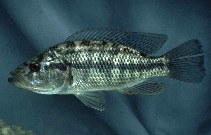| Family: |
Cichlidae (Cichlids), subfamily: Pseudocrenilabrinae |
| Max. size: |
35 cm SL (male/unsexed); max.weight: 1,500.0 g; max. reported age: 6 years |
| Environment: |
demersal; freshwater |
| Distribution: |
Africa: Angola, Botswana, Namibia, Zambia, Zimbabwe and Democratic Republic of the Congo. In the Cunene River system (Angola and Namibia); Okovango River and swamps; upper Zambezi system including Lake Cameia, Kafue River and Luangwa system (Ref. 5693). Luapula-Mweru, Lulua River, Angolan Kasai (upper and middle Congo River basin)(Ref. 5693, 97233) and Cuanza River in Angola (Ref. 120641). |
| Diagnosis: |
Description: deep-bodied; frontal profile moderately steep with a straight to slightly curved outline; head and eyes large; caudal fin rounded (Ref. 52307).
Coloration: head and body olive brown to olive-green, with front and dorsal areas darker; juveniles and females with 7 dark, olive-brown vertical bars on body and 1 dark horizontal band mid-body; males more intensely colored, often with dark-centered body scales and pale dots in soft dorsal, and always with some rosy to rusty-red egg spots in anal fin; caudal fin olive with a red outer margin; dorsal fin also outlined in red; when courting, males with a purple to reddish-brown coloration on cheeks and opercles that may extend to anterior body parts (Ref. 52307). |
| Biology: |
Common in a broad range of habitats from mainstream margins to floodplain channels and lagoons; preys on insects and small fish, including mormyrids and barbs, which are taken near the bottom; breeds in spring and early summer at low water before the annual floods arrive; relatively few eggs are laid and mouthbrooded; matures after 1-2 years (Ref. 7248). Agamous, maternal mouthbrooder (Ref. 52307). Also caught with drawnets. |
| IUCN Red List Status: |
Least Concern (LC); Date assessed: 01 May 2009 Ref. (130435)
|
| Threat to humans: |
harmless |
Source and more info: www.fishbase.org. For personal, classroom, and other internal use only. Not for publication.
